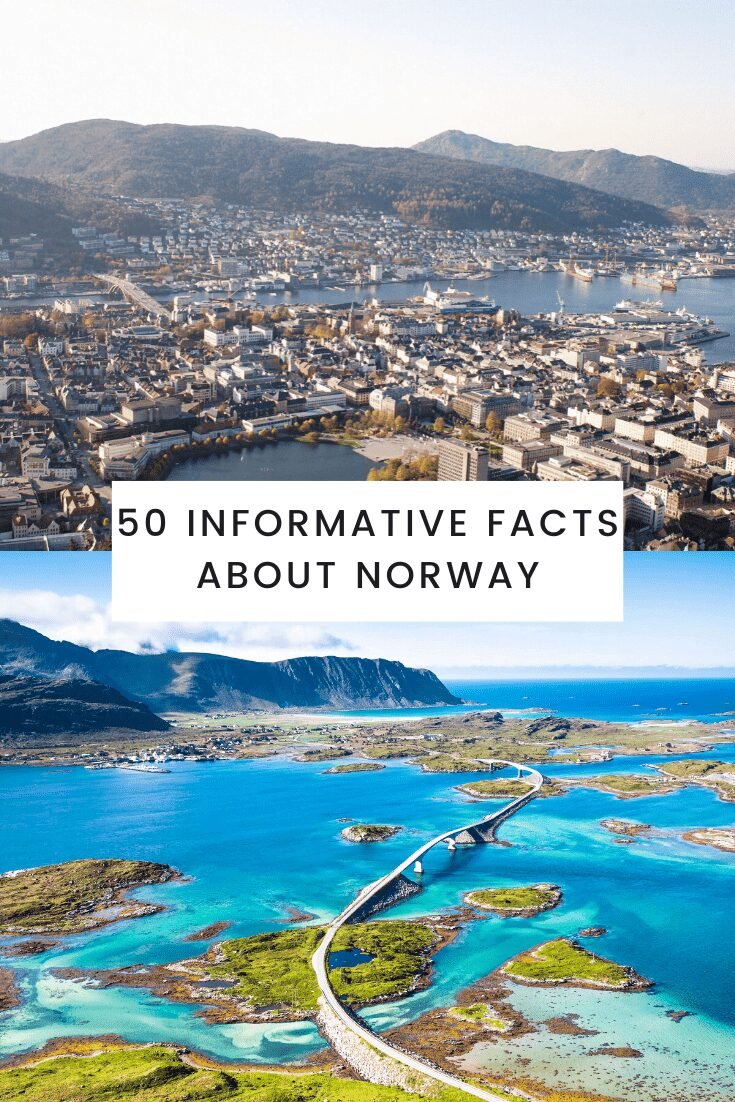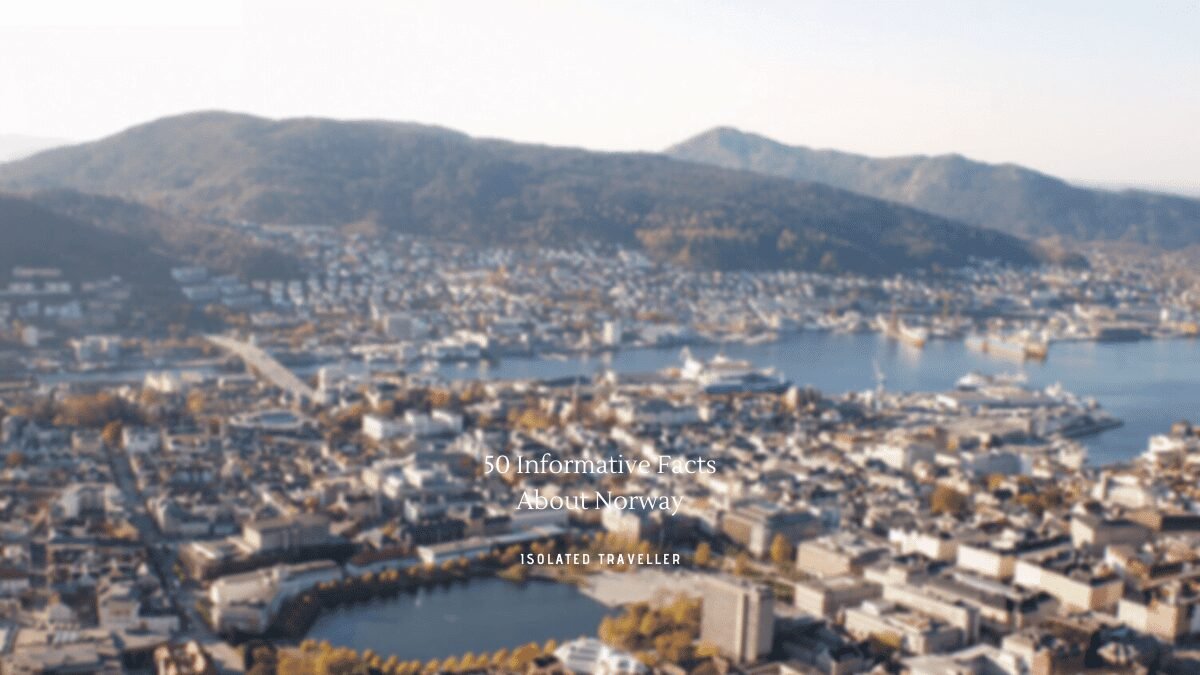Facts About Norway
-
Norway has two official names: Norge in Bokmål and Noreg in Nynorsk. The English name Norway comes from the Old English word Norþweg mentioned in 880, meaning “northern way” or “way leading to the north”, which is how the Anglo-Saxons referred to the coastline of Atlantic Norway similar to the scientific consensus about the origin of the Norwegian language name. The Anglo-Saxons of Britain also referred to the kingdom of Norway in 880 as Norðmanna land.
-
Norway has a total area of 385,207 square kilometers.
-
The Population of Norway is 5.368 million, as of 2020.
-
Norway has the fourth-highest per-capita income in the world on the World Bank and IMF lists.
-
Norway ranked first on the World Happiness Report for 2017 and currently ranks first on the OECD Better Life Index, the Index of Public Integrity, and the Democracy Index.
-
Norway is also the world’s second-largest exporter of fish, in value.
-
Hydroelectric plants generate roughly 98–99% of Norway’s electric power, more than any other country in the world.
-
Norway borders three countries: Finland, Sweden, and Russia. The longest border is shared with Sweden.
-
Norway’s highest mountain is called Galdhoppigen and is 2,469 m/8,100 ft high.
-
The largest lake in Norway is Lake Mjøsa.
-
In Norway, life expectancy rates are one of the highest in the world.
-
The biggest fjord in Norway is Sognefjord. This fjord is often referred to as the ‘King of Fjords’.
-
Norway’s flag is red with a blue cross outlined in white that extends to the ends of the flag.
-
The cheese slicer was invented in Norway in 1925 by Thor Bjørklund.
-
The official Christmas tree in Trafalgar Square in London has come from Norway every year since 1946.
-
Norway is the world’s largest exporter of salmon.
-
Since 2008, same-sex marriage is allowed in Norway.
-
“Allemannsretten” is a term that says that every man and woman in Norway has the right of public access.
-
The Norwegians founded Dublin, Ireland, in A.D. 836.d
-
Norway’s Hardangervidda Plateau is the biggest mountain plateau in Europe and home to the continent’s largest herd of wild reindeer.
-
In 1990, Norway established a permanent research station, named Troll, in the Antarctic.
-
Between 1380 and 1418, Norway and Denmark were a union. And between 1814 and 1905, Norway and Sweden formed an alliance.
-
In January 1993, Norway’s Erling Kagge became the first man to go alone and entirely unaided to the South Pole.
-
Norway has won more medals in the Winter Olympics than any other country, with 332 to date since the first Winter Olympic Games in 1924.
-
Norwegian King Olav V won an Olympic gold medal in sailing in 1928 and was an active sailor all his life.
-
The Holmenkollen Ski Festival is the world’s oldest, established as early as 1872.
-
Norway introduced Salmon Sushi to Japan in the 80s.
-
Norway and Svalbard islands have 1190 fjords collectively.
-
Norwegians are avid readers. They spend more time reading than any other country in the world.
-
The office Language of Norway is Norwegian, however, More than 86% of the Norwegians make use of the English language for communication.
-
The country does not have any official religion.
-
The World’s Sixth tallest Waterfall is located in Norway, Vinnufossen which is 860 m in height.
-
The country also has the largest glacier in mainland Europe – Jostedalsbreen, at 487 square kilometers.
-
Hornindalsvatnet in Central Norway is Norway’s and Europe’s deepest lake – 514 m.
-
Eiksund is the deepest undersea tunnel in Norway. It is a 7776 m long subsea tunnel on the north-west coast of Norway.
-
There are 25 national parks on Norway mainland.
-
There are almost 300 mountain peaks that are above 2,000 meters.
-
Roald Dahl, the English author of Norwegian descent-based his «Charlie and the Chocolate Factory» on the Freia chocolate factory in Oslo.
-
Football has the highest participation level of any sport in Norway.
-
The national day of Norway is officially called ‘Norwegian Constitution Day’. It is celebrated on May 17th to commemorate Norway’s constitution of 1814.
-
Norway has obligatory military service. This lasts for 19 months and applies to men and women. It is the only European country to enforce national service on women and men.
-
The Nobel peace prize is annually awarded in Oslo since 1901.
-
Norway’s sovereign wealth fund is currently worth around $1 trillion.
-
In 2008, Norway knighted a Penguin – Sir Nils Olav
-
In 1251, Henry III of England was given a polar bear by the King of Norway. He kept it in the Tower of London, on a long chain so that it could swim in the Thames.
-
Cape Nordkinn in north Norway is the most northerly point of Continental Europe.
-
Norway has one active volcano. It is called Beerenberg and is on the island of Jan Mayen.
-
One of the world’s most iconic works of art, “The Scream,” was painted by Norwegian artist Edvard Munch in 1893.
-
Norway was a founding member of the United Nations, NATO, and the European Free Trade Association. It is not a member of the European Union.
-
Norway has the lowest reconviction rate (20%) of released prisoners in the world.

Other Interesting and Informative facts that you might enjoy:
Find Out More About Norway with Visit Norway, External Link

